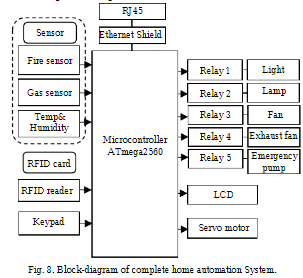
components
Hardware Components
Arduino ethernet shield
X 1
Arduino Mega 2560
X 1
Fire sensor
X 1
RFID Reader
X 1
Temp & Humidity sensor
X 1
Servo motor
X 1
keypad
X 1
details
I. INTRODUCTION
Internet of Things (IoT) is one of the mostly talked research topics in the recent years. IoT based home automation system is getting popularities day by day. Home automation is the controlling of the different home appliances using smart devices anywhere in the world without the need of physical presence in the home. Smart home system is very beneficial in everyday life as it saves electricity and reduces worries for home security of working people. Due to the secure, easily controllable and monitorable features, advanced home automation system design has become a core interest for many researchers.
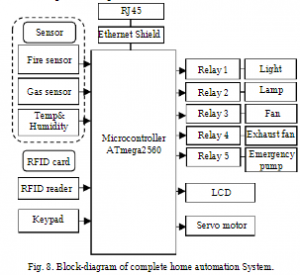
II. RELATED WORK
Nowadays IoT makes technology more advanced. IoT is the network protocol integrated with physical devices, home appliances and other embedded devices which enables these things to connect and exchange data over a network without the presence of human being [6]. IoT has a novel impact on home automation system. Smart home is not a new term, it has been developed from over a decade. Home automation or smart home provides convenience, comfort, security and energy efficiency to its householders [7] [8]. Smart home consists of wireless technology such as Wi-Fi, RFID, Bluetooth and cellular networks. These have been utilized to various embedded systems which sense, control and exchange remote data.
III. DESCRIPTION OF THE SYSTEM
A. System Architecture
This section describes the details architecture of the proposed system. The system architecture is divided into five layers; remote login, server connectivity, real time database with notification system, home gateway and home environment. Remote login allows the authorized user to login and access the system with ‘Home Automation’ app from anywhere in the world using Wi-Fi or 3G/4G network. Server connectivity is controlled by Teleduino server, which links up between IoT platform and embedded micro- web server using a unique key. Teleduino converts Ethernet enabled Arduino into a versatile tool for interacting with devices over the internet. Ethernet enabled Arduino automatically connects itself to the Teleduino server when it
is powered on.
B. System Implementation
This section presents the explanation of working principle of the proposed system. The home gateway system is divided into two-parts; server connectivity and TCP/IP protocol. The server connectivity has three sections; Teleduino server, micro-web server, and Altair SmartCore server. JSON response to communicate between the remote user and the micro-web server. JSON is much more lightweight for storing and exchanging data over client-server. It is easy for human beings to parse and generate messages simpler and faster than XML. For example, to turn a light on, an HTTP POST sends a request to micro-web server via Teleduino Server. After a successful operation the system sends response with success status response code “status”: 200. The complete operation is illustrated as a data flow diagram in Fig. 3.
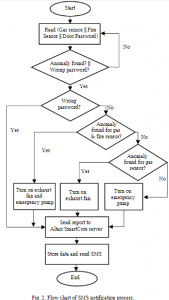
D. Smartphone and Web Application
There are several platforms for developing smartphone application such as Android, Windows Mobile, iOS and others. About eighty eight percent people of the world use Android operating system as Android GUI is much simple and sophisticated [20]. Web application has been used productively because of the increased availability of information. These increases have led to heavier reliance on web-based application. Also, a web application can access anytime, anywhere through any web browser in any operating system with an internet connection. That is why this proposed system introduces both web application and smartphone application to control the home appliances. Fig. 4 and Fig. 5 illustrate the GUI of ‘Home Automation’ Android app and web application.
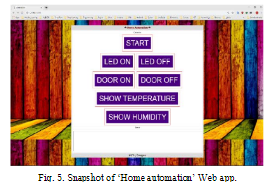
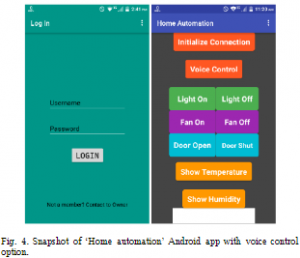
IV. EXPERIMENTAL SETUP AND HARDWIRE CONFIGURATION
The home automation system has used Arduino Mega as microcontroller board which works as the central control unit. Various modules including gas sensor, temperature and humidity sensor, RFID module, keypad, LCD, Relays and light/fan are interfaced to the Arduino board for testing the project. The experimental configuration and implementation of speech or manual control based home automation system are shown in Fig. 6 and Fig. 7
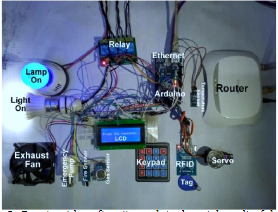

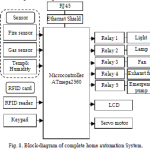
COMMENTS